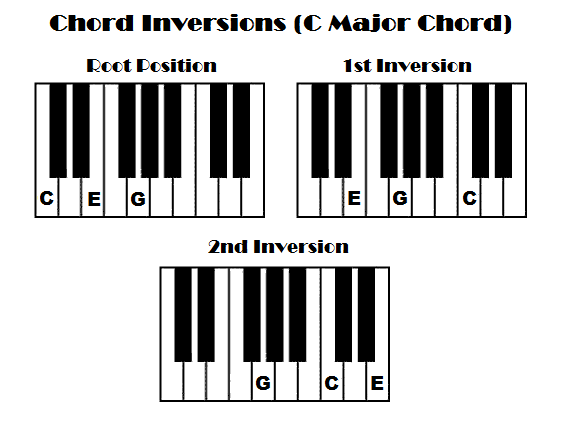I will explain chord inversions to you. You will learn about chords in their root position as well as their first inversion and second inversion. We will also touch on 3rd inversions of seventh chords.
A subscriber on my Piano Keyboard Guide YouTube channel did not understand chord inversions and I started answering their question as a comment. My response was getting a bit lengthy and I decided to turn it into a blog post so that everyone can benefit. This allows me go into greater detail. I trust that you will benefit from this. Be sure to leave me a comment below so I know for sure that you’re with me. 🙂
To form the first or second inversion of a chord all you do is switch the notes around (invert them) and play these notes either higher or lower on your piano. For instance, the notes of the C major chord are C, E and G. In root position, this chord is played with the note, C as the lowest notes, E in the middle, and G as the highest note. Root position of the C major chord is C-E-G.
To form the first inversion of this chord, instead of C being your lowest note, you make it the highest note in the chord. Therefore, E becomes the lowest note, G is in the middle and C is played an octave higher. The C major chord in its first inversion is therefore, E-G-C.
You can invert this chord further and play the notes in the order, G-C-E. This is known as the second inversion of the C major chord. G is the lowest note, C is in the middle and E becomes the highest note.

What’s the point of chord inversions? Inversions help you move smoothly between chords. For instance, let’s say you play a C major chord whose notes are C, E and G, as we have seen. Let’s say you are playing a song and the C major chord is followed by an F major chord. Instead of shifting all your fingers and playing the F major chord in its root position (F-A-C), all you have to do is shift two fingers. All you have to do is leave your finger on the note, C, and play F and A. C-F-A is the second inversion of an F major chord.
Let’s take a look at another example. Let’s say you want to move from a G major chord to a C major chord. Let’s say you’re starting with a G major chord in its root position, G-B-D. Instead of having to move all your fingers and play the C major chord in its root position (C-E-G), all you do is leave your finger on G, and move two fingers, giving you G-C-E. G-C-E is the second inversion of the C major chord.
So a chord can be played with the notes in different orders, depending on the sound you intend to create, or to allow you to smoothly move from chord to chord in a chord progression. In other words, the fact that the notes of the C major chord (for example) are C, E and G, doesn’t mean that the notes are always played with C as the lowest note, E in the middle and G at the top. It can be C-E-G (root position), E-G-C (1st inversion) or G-C-E (2nd inversion).

Let’s look at this another way, although it all points to the same thing. A major chord (for instance) is made up of a root, a third and a fifth. For instance in a C major chord, C is the root, E is the third and G is the fifth. In root position, the root is the lowest note. In its 1st inversion, the third is the lowest note. For the 2nd inversion, the 5th is the lowest note.
Any chord can be inverted. The chords we’ve looked at so far have all been major chords, but this can be done with any type of chord, whether minor, augmented, diminished, seventh, and so on. The more notes there are in a chord, the more inversions are possible. For example, the notes of the C dominant 7th chord are C, E, G and Bb. In root position, the notes of Cdom7 are C-E-G-Bb. In its 1st inversion, it’s E-G-Bb-C. In its 2nd inversion, it’s G-Bb-C-E. In its 3rd inversion, it’s Bb-C-E-G.
Here’s an example of a minor chord. The notes of the A minor chord are A, C and E. In root position, play A-C-E. In other words, A should be the lowest note in the chord, C is in the middle and E is your highest note. The 1st inversion of the A minor chord is C-E-A. The 2nd inversion of the A minor chord is E-A-C.
Root position means that you start the chord with its root note. The root is the note which corresponds to the letter name of the chord. In root position, the root is the lowest note in a chord.
Practice playing chords in their root position, first and second inversions. Start with major chords then move to minor chords. You can even practice them mentally, when you are away from the piano. After learning major and minor chords, you can move to other types of chords, like augmented, diminished, suspended, and extended chords. I take a look at lots of chords on this page. You can click on the major and minor chords in particular and learn how to play them in root position as well as 1st and 2nd inversions.
I trust that you’ve learned a lot. It was a pleasure explaining chord inversions to you. Please leave me a comment. My name is Mantius Cazaubon. All the best!